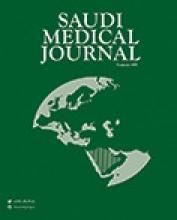Abstract
OBJECTIVE: To determine the outcome of various techniques of vascular repair in terms of repair related complications and limb salavagibility.
METHODS: From January 1999 to December 2005, this retrospective study was conducted in the Department of General Surgery, Lahore General Hospital, Lahore, Pakistan. The patients, who underwent various surgical interventions for extremity vascular trauma, were included in this study. Those, who underwent primary amputation due to non-salvageable injuries or who presented with late complications of vascular injuries were excluded.
RESULTS: Ninety-three patients underwent different surgical procedures for extremity vascular trauma. Majority of the patients were young, mean, 29.4 years male 91.3%. Penetrating trauma was the most common mode of injury 77.4%. The median time interval between injury and repair was 4.5 hours. Superficial femoral artery was the most frequently injured artery 26.8%. Graft repair was carried out in 41 patients 46.6%, while 34.1% of the patients had end-to-end anastomosis. Wound infection was the most common complication 18.2%. Seven patients 7.5% had secondary amputations and 3 3.2% died from other injuries. Vascular reconstruction was successful in 89.3% of the patients.
CONCLUSION: Early revascularization by employing simple repair or interposition autogenous vein graft repair results in successful limb salvage with acceptable complication rate.
- Copyright: © Saudi Medical Journal
This is an open-access article distributed under the terms of the Creative Commons Attribution-Noncommercial-Share Alike 3.0 Unported, which permits unrestricted use, distribution, and reproduction in any medium, provided the original work is properly cited.






